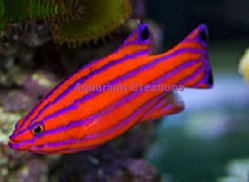Aquarium Conditioned
Swalesi Basslet
Liopropoma swalesi

Identification:
Liopropoma Swalesi is a small deep water basslet commonly found around the waters of Indonesia. It looks like other members of the genus Liopropoma, sleek, streamlined, with a body shape that resembles an arrowhead. It rarely tops 3 inches while most specimens come at 1-1/2 to 2-1/2 inches in size. Common names include the Pacific Candy Basslet, Swalesi Basslet, Swales Swissguard Basslet. An excellent reef fish, the Swalesi Basslet may only pose a threat to smaller, ornamental crustaceans such as such as porcelain crabs, anemone shrimp, etc.
Tank Recommendations:
Provide at least a 10 gallon aquarium with plenty of live rock for a single individual. Basslets prefer a tank with lots of rock work to hide in and sleep. Since it is found in the deeper waters of the Caribbean, it needs areas of the tank to have lower light levels either through less bright aquarium lighting or cave areas that hide it from the bright lighting. Though perfectly friendly and peaceful with tank mates of close size, the basslets territorial with their own species. That means it will be aggressive toward another Swalesi Basslet so we suggest only one per tank.
Food and diet:
Basslets adapt very quickly to frozen foods after just a few days. Carnivores they mainly feed on crustaceans found on the sandy bottom of its natural environment. In the aquarium they should be fed a variety of meaty food items such as live, frozen, freeze-dried, and vitamin enriched brine shrimp, mysis shrimp, krill, and silver sides. They will also readily accept carnivore/omnivore (Spirulina based) pellets. Feeding should be 1 to 2 times per day and only what will be consumed within a few minutes.
Level of Care:
Moderate
Acclimaton Time:
3+ hours
Reef Compatibility
: Excellent
Approximate Purchase Size:
Small: up to 1" Medium: 1" to 1-3/4" Large: 1-3/4" to 2-1/2"
|
Small$99.99
Medium $109.99
Large $139.99
|
|

